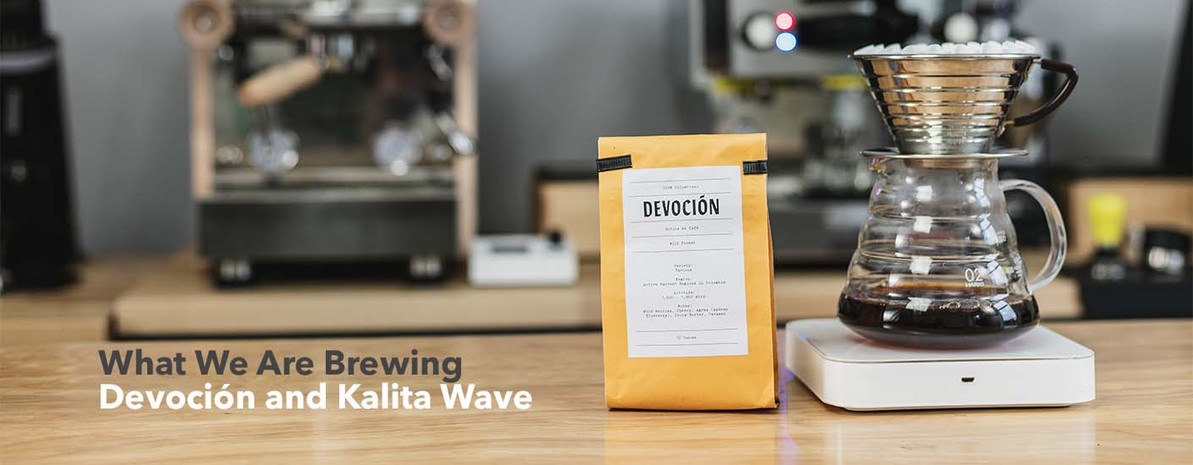What We Are Brewing: Devoción
The office at Prima is always stocked with coffee. Always. Since we sell coffee equipment, and only that with which we have been able to make consistently tasty cups, we find it necessary to sample coffees from all over the country, at times the world, and, although we prefer lighter roasts, from all over the color spectrum. Until now, this has remained our little secret. We grind and brew coffees. We measure extraction percentages. We taste and talk among ourselves. Then we refine recipes and brew some more. It is part of our job and, dare we say, it is fun. This year we have been sharing some of that fun and the recipes that result. This episode features Devoción.
Out of all the coffee roasters we have showcased, Devoción has the most unique business model. The first indication of this is found on the bag, which is stamped with two dates: the roast date, a fairly typical marker of care and accountability, and a green date. It is the latter that sets Devoción apart. After a coffee cherry is harvested and milled, what remains—the beans—enters the “green” stage. This is usually when the green beans are packaged, transported, and shipped to the destination country through an importer. Then comes storage and eventually roasting. By the time we open the retail bag, grind, and brew, several months have likely passed; in the case of some coffees, possibly years. (Read more about sourcing green coffee in Ryan Brown’s Dear Coffee Buyer.) As with most harvested crops, those that aren’t frozen in a sophisticated manner à la George Howell, age matters. With Devoción, however, the timeline from harvest to roast is negligible: certainly fewer than 30 days but sometimes as fast as 10. Unlike other roasters, Devoción has a presence in two countries: Colombia and the USA. It is able to package and ship the green beans from one location (Bogotá) to the other (Brooklyn), where it is roasted and served (in the case of its cafés) or shipped (in the case of online sales). No importer. No waiting.
For context, the Wild Forest coffee we ordered is stamped with a Green Date of September 6 and a Roast Date of September 24. We were drinking it one week later. In less than a month, the coffee went from farm to cup.
Wild Forest is one of Devoción’s house blends. This one is made up of only Caturra and has notes, says the bag, of berries and cherries and a little bit of caramel. We agree and here’s why: It is a juicy coffee with a creamy mouthfeel. We have been brewing this on the classic Kalita Wave 185 with a ratio of 1:14.5. The classic ratio is good, too, but we have found that by reducing the water volume, we are able to push the tart cherry. Water matters, too, so pick up some Third Wave Water or a Peak pitcher if the coffee tastes dry. This recipe is perfect for one person. If sharing, experiment with higher doses and different ratios.
| Roaster: | Devoción |
|---|---|
| Coffee: | Wild Forest |
| Process: | Washed |
| Brewer: | Kalita Wave 185 |
| Grind: | Medium |
| Dose: | 17 grams |
| Water: | 250 grams at 205–208°F |
Before the brewing begins, all the prep work must be done. Heat the water. Grind the coffee. Rinse the filter with hot water. Add the ground coffee. Tare the scale. Start the timer.
- Start with a pour of about 50g of water. Try to avoid the walls where the water may slip past the coffee. Stir gently to incorporate all the grounds, enough to mix the solution but not to overly agitate it. Put the kettle back on the heat to maintain the desired temperature.
- At about 45 seconds, pour 100g of water slowly in concentric circles. Stay high enough to create agitation but not so high that the water splashes. Keep from pouring against the wall. Give the vessel a swirl.
- At about the 2-minute mark, pour the remaining 100g of water. Use the same technique: high but not too high. Give the vessel one last swirl.
The brew should finish between 3 and 4 minutes (depending on the grinder). With the Kalita Wave, more than perhaps other drippers, the finished coffee bed provides a clear indication of the grind size match. If the coffee bed is muddy, grind coarser next time. Time is helpful, too. If the coffee drained too quickly (under 3 minutes), grind finer next time. With the latter, the bed is probably going to look dry and chunky like mulch. As with all coffee brewing, though, let taste be your guide because what really matters is that the person drinking it, i.e., you, likes it. Don’t let anyone tell you otherwise.
If you make this recipe, or have another recipe you would like to share, please comment below. Cheers.



